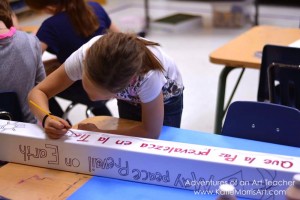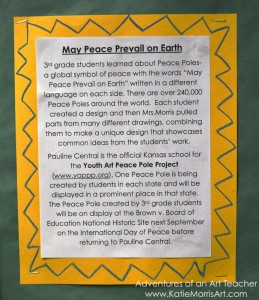Katie Morris, from Pauline Central Primary School and her 3rd graders completed their Peace Pole in May, a few weeks before the end of the school year. When we first talked about Peace Poles, we brainstormed a list of things that “Peace Is” and “Peace Isn’t”. It helped students start thinking of ideas. Each student drew out a design for one side of a Peace Pole. When they were finished, I looked for common themes and organized many student ideas into one Peace Pole. There were images of friends, people holding hands, flags to represent peace in the USA, the ocean, and space. When students were asked what they learned, the consensus was that “doing peaceful things is nice, doing un-peaceful things is not”. During our Peace Is/Peace Isn’t discussion, bullying and not including people was brought up as something that “Peace Isn’t”. That was a perfect tie-in to the location planned for the International Day of Peace. Our Peace Pole will be displayed at the Brown vs. Board of Education National Historic Site. The students, who will be in 4th grade at the time, will get to go on a field trip to the NHS, where they will present a program tying the Civil Rights movement to Peace. This was a very valuable experience for the students, and for me. Other grades are asking if they can make a Peace Pole, too, and I’ve started planning one for my other school, Pauline South Intermediate, for next school year. I also want to mention the languages we chose. English and Spanish were the most obvious choices, since they are the most common languages spoken in our community. Chinese was chosen because the students were drawn to the look of the characters and since it is spoken so far away from us. The unusual choice we made was to include sign language. American Sign Language is one of the most common languages used in our school district, so we decided to represent it by drawing hands signing “Peace on Earth.” Thank you for this opportunity! Katie Morris.
Katie wrote on her fantastic Blog: http://www.katiemorrisart.com/2014/08/peace-poles.html?spref=tw
Peace Poles are one of the most recognizable symbols of peace and can be found all over the world. The designs vary, but they always share the message “May Peace Prevail on Earth” in a different language on each side. My students learned about Peace Poles, proposed designs, and helped paint the collaborative project that I designed based on their proposals. This September our Peace Pole will represent Kansas and be displayed at the Brown v. Board of Education National Historic Site before returning to school where it will permanently reside.
I chose 3rd graders to work on this project because they are the oldest grade I see weekly. This would have been better suited to an older grade level but the schedule just wouldn’t allow it! To begin our lesson, we spent a bit of time talking about “Peace”. What is it? What isn’t it? It didn’t take long for students to think of a big non-example in schools- bullying. I hoped that they would think of bullying. We talked about examples of bullying- physical, name-calling, excluding people, etc. I really wanted to make sure that we touched on bullying because I think it will help them better understand discrimination when they learn about the Brown v. Board case that ended legal segregation in public schools. Thankfully the lovely people at the Brown v. Board site and the students’ new principal (they switch schools between 3rd and 4th grade) are excited about planning a field trip to the NHS this September when the Peace Pole will be on display. I only hope it can be scheduled on a day that I’m at the intermediate school so I can attend, too!
After our Peace Is/Peace Isn’t discussion and intro to Peace Poles, the students set to work on their own designs. I gave the students narrow paper to help them think of the vertical peace pole design. They also had transparencies to look at with “May Peace Prevail on Earth” translated into something like 60 different languages. When the drawings were finished, I dug through them looking for designs that stood out with interesting visualizations of peace and for common themes. I sorted the strongest designs into 4 piles that eventually became the 4 sides of our Peace Pole.
Students were invited to add thoughts to the giant paper Peace Sign brainstorming chart sometime during the first class period. It had great visual impact in the hallway and also helped to remind the students and inform others of our preparatory activities. I drew the designs out on our Peace Pole with a sharpie and the students painted with acrylic and a bit of tempera. I called one table up at a time to let students paint. This is where I had to give lots of gentle reminders about not rushing! The ocean section was totally designed by one of the 3rd graders. She made the octopus’ legs spell out “Peace” and the sea horse’s bubbles form a heart. The next photo shows one of the languages we chose. English and Spanish were the most obvious languages as they are the most common in our area. I had asked one of our ELL teachers about languages common in our school district and I was surprised to find out that American Sign Language was toward the top. Of course I realize that someone who uses ASL can likely read English, but we still thought it would be fun to represent sign language on our Peace Pole. Our interpreting para signed “Peace on Earth” for me to photograph and I went from there. It’s hard to get a good photo of the Peace Pole since it’s 7 feet tall and skinny. I merged 8 photos together to show what it would look like flattened out. Hopefully you can enlarge and see some detail. I think that a Peace Pole would be a wonderful addition to any park or garden. I’m going to see if we can get one made at my intermediate school this year!
Jim from YAPPP would like to add one thing: “Katie you are AMAZING!”









